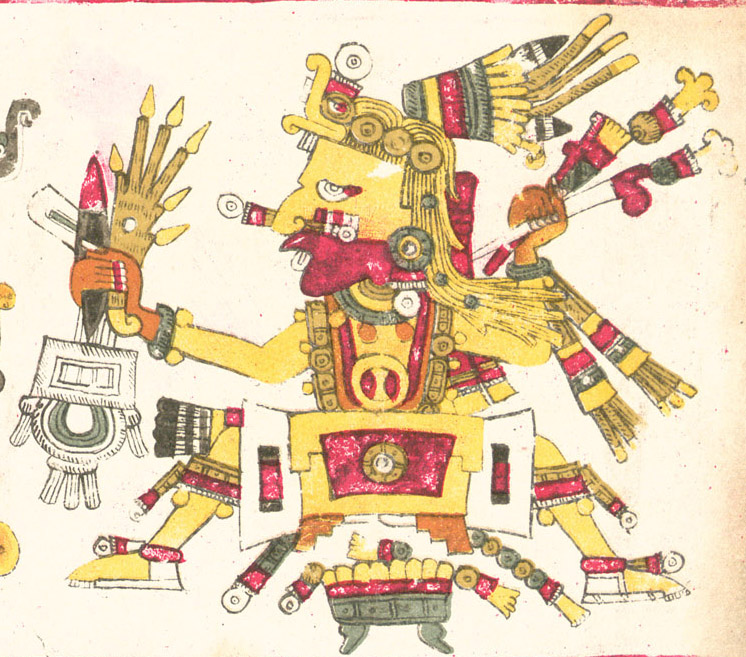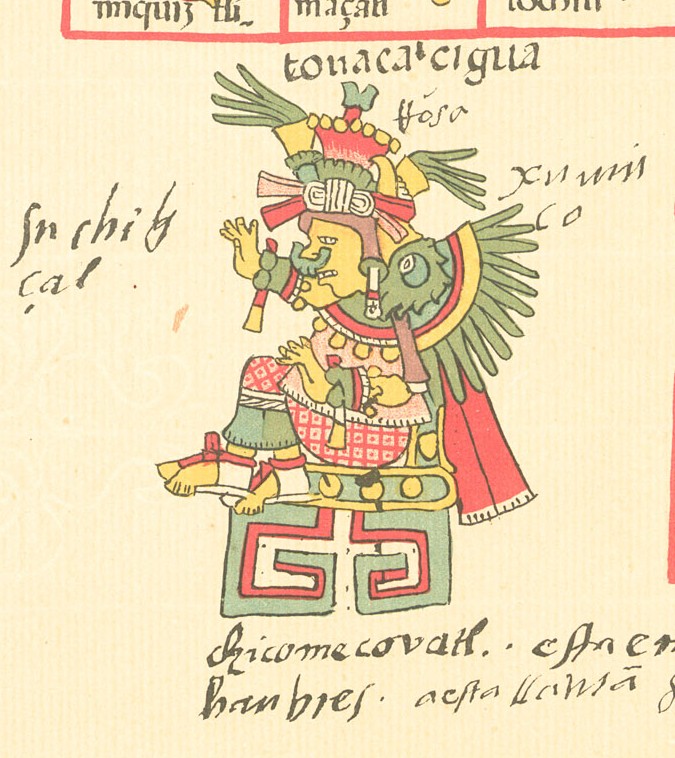ĹŚmeteĹŤtl on:
[Wikipedia]
[Google]
[Amazon]

 () ("Two gods") is a name used to refer to the pair of
() ("Two gods") is a name used to refer to the pair of

 Multiple Nahuatl sources, notably the ''
Multiple Nahuatl sources, notably the ''

 () ("Two gods") is a name used to refer to the pair of
() ("Two gods") is a name used to refer to the pair of Aztec deities
Aztec mythology is the body or collection of myths of the Aztec civilization of Central Mexico. The Aztecs were Nahuatl-speaking groups living in central Mexico and much of their mythology is similar to that of other Mesoamerican cultures. Accordi ...
and , also known as and . translates as "two" or "dual" in Nahuatl
Nahuatl (; ), Aztec, or Mexicano is a language or, by some definitions, a group of languages of the Uto-Aztecan language family. Varieties of Nahuatl are spoken by about Nahua peoples, most of whom live mainly in Central Mexico and have smaller ...
and translates as "god". The existence of such a concept and its significance is a matter of dispute among scholars of Mesoamerican religion. Ometeotl was one as the first divinity, and Ometecuhtli and Omecihuatl when the being became two to be able to reproduce all creation
Definition

 Multiple Nahuatl sources, notably the ''
Multiple Nahuatl sources, notably the ''Florentine Codex
The ''Florentine Codex'' is a 16th-century ethnographic research study in Mesoamerica by the Spanish Franciscan friar Bernardino de Sahagún. Sahagún originally titled it: ''La Historia General de las Cosas de Nueva España'' (in English: ''The ...
'', name the highest level of heaven or "place of duality" ( specifically terms it "in in " or "the place of duality, above the nine-tiered heavens)." In the , Franciscan priest translated a Nahuatl source reporting that in this layer of heaven there existed "a god named , which means two-gods, and one of them was a goddess." The ''History of the Mexicans as Told by Their Paintings
{{unreferenced, date=April 2016
The ''History of the Mexicans as Told by Their Paintings'' ( es, Historia de los Mexicanos por sus pinturas) is a Spanish language, post-conquest codex written in the 1530s. This manuscript was likely composed by Fat ...
'' () names the inhabitants of the uppermost heaven and (Lord and Lady of Abundance). concurs that these are epithets of "in in ", giving as another name of "in " ("the mansion of the Lord of Abundance").
There is some evidence that these two gods were considered aspects of a single being, as when a singer in the asks where he can go given that " " ("they, God, stand double"). The reports of the two that "" (''they were raised and had always been in the thirteenth heaven; nothing was ever known of their beginning, just their dwelling and creation, which were in the thirteenth heaven'').
As a result of these references, many scholars (most notably ) interpret the rare name as "Dual God" or "Lord of the Duality". further argues that was the supreme creator deity
A creator deity or creator god (often called the Creator) is a deity responsible for the creation of the Earth, world, and universe in human religion and mythology. In monotheism, the single God is often also the creator. A number of monolatris ...
of the Aztecs, and that the Aztecs envisioned this deity as a mystical entity with a dual nature akin to the European concept of the trinity
The Christian doctrine of the Trinity (, from 'threefold') is the central dogma concerning the nature of God in most Christian churches, which defines one God existing in three coequal, coeternal, consubstantial divine persons: God the F ...
. He argues that the Aztecs saw as a transcendental deity and that this accounts for the scarcity of documentary references to it and the absence of evidence of an actual cult to among the Aztecs.
Critique
Other scholars however, notably Richard Haly (1992), argue that there was no , or among the Aztecs. Instead, he claims, the names should be interpreted using the Nahuatl root ("bone"), rather than ("two"). Haly further contends that was another name for and , both gods related to the creation of humans from dead bones. He argues that, of the five sources used by to argue in favor of the existence of a single creator god among the Aztecs, none contains a clear reference to a god of duality. First, cites the Franciscans, Franciscan , who affirms in his chronicle that the "Indians wanted the divine Nature shared by two gods". In his translation of the introduces a reference to the "God of duality" where it is not explicitly found in the original text, which reads "". Haly argues that erroneously unites "stands dual" with the Spanish loanword ("God") to invent this dual deity. Another example given by is from the : "", literally "two-god, creator of humanity." Haly, reading the interjection as part of a longer (and similarly unattested) , argues that this should rather be translated as "juicy maguey God" as the text talks about the imbibing of pulque. The has a representation of a god labelled  — iconographic analysis shows the deity to be identical to . The fifth source is the ''History of the Mexicans as Told by Their Paintings'' which Haly shows does not in fact read , but rather ", ("bone-lord") who is also called " and is explicitly stated to be identical to . James Maffie in his book Aztec philosophy poses the argument that Aztec religion was pantheistic centered on the entity Teotl. As a result of the pantheism proposed by Maffie that he claims was practiced by the Aztecs, it is by definition not possible that Ometeotl can be a “God of Duality” that is separate from Teotl, which is contradictory to the way in which Leon-Portilla talks about Ometeotl as a transcendental creator god.Ometeotl, the God that Didn’t Exist, Itztli Ehecatl. http://www.calmecacanahuac.com/blog/uncategorized/ometeotl-the-god-that-didnt-exist/. 2014Notes
References
* * * * * * * * * * * * {{DEFAULTSORT:Ometeotl Aztec gods Creator deities